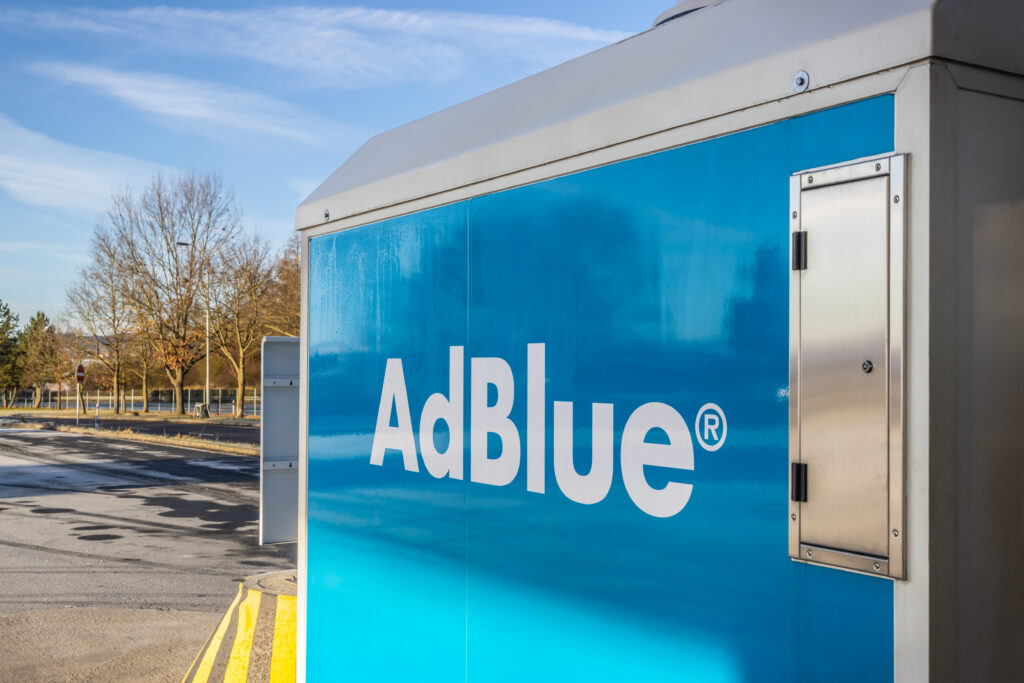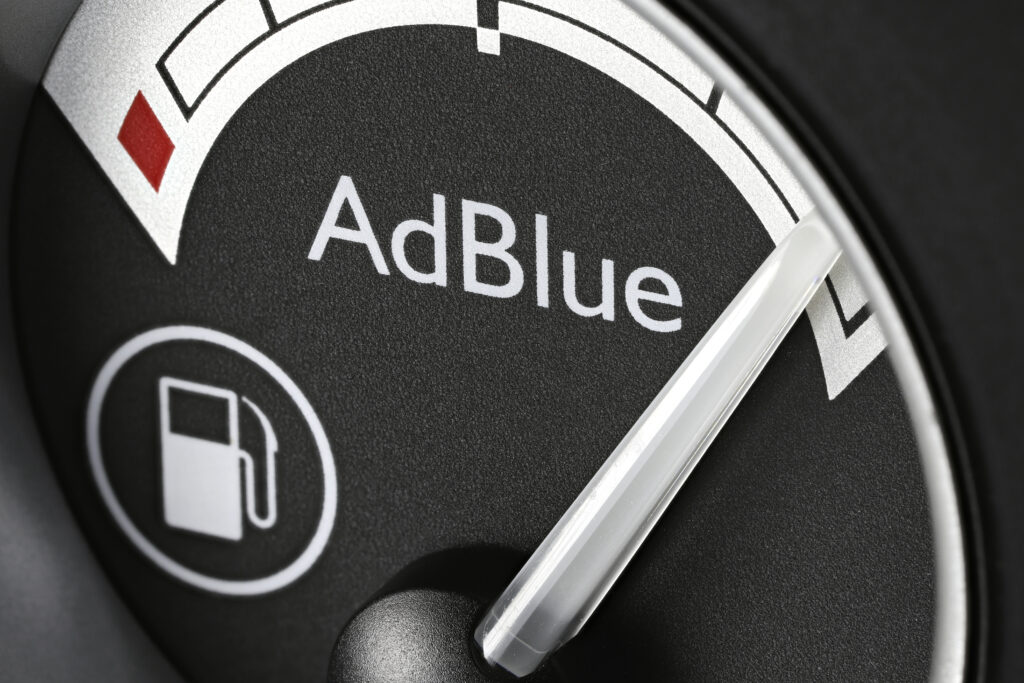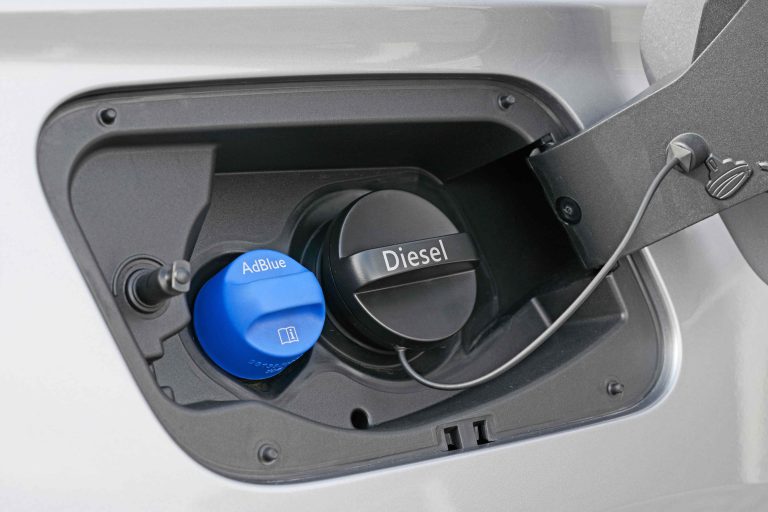What is AdBlue? If you drive a modern diesel vehicle, you’ve probably heard of it. But what exactly is it? How do you use it? And what does it do for your car?
We’re going to share everything you need to know about AdBlue and your vehicle.
What is AdBlue used for?
AdBlue is a fairly recent innovation. You may also hear it referred to as “Diesel Exhaust Fluid,” or DCF. It’s designed to help reduce the toxic emissions from vehicles fueled by diesel.
The legal limits on vehicle emissions have been reduced sharply in the last few years. The Euro 6 standards, introduced by the EU in 2016, are one of the more recent changes. They cut the limit on nitrous oxide (NOx) emissions from diesel vehicles from 180 to 80 milligrams per kilometre.
That’s good news for our air quality, especially for people with respiratory conditions like asthma. But it’s meant that manufacturers have had to look hard at how they can make their vehicles cleaner and greener.
AdBlue is part of the answer. It’s specifically designed to reduce the amount of nitrous oxide emitted from diesel vehicles.
How does AdBlue work?
As you drive, AdBlue is sprayed into the exhaust system. That’s a hot environment, and at high temperatures, the urea turns into ammonia. That ammonia then combines with the nitrous oxide produced when diesel combusts, converting it into nitrogen and water.
What is AdBlue made of?
AdBlue is a liquid mixture of urea and deionised water. And it works because of the way it reacts with the chemicals in your vehicle’s exhaust.
What does AdBlue do to reduce emissions?
AdBlue reduces emissions through a process known as selective catalytic reduction or SCR. And while it doesn’t completely eliminate nitrous oxide emissions, it does cut them dramatically. The result is a cleaner exhaust — and cleaner air.
Is AdBlue the same as diesel?
AdBlue is only used in diesel vehicles, but it’s not the same thing as diesel. Diesel is a hydrocarbon, made from crude oil. But AdBlue, as we’ve seen, is made from urea and distilled water.
The urea content in AdBlue has led to rumours that it’s made from pig urine. Pig urine does indeed contain urea (as does human urine!). But it wouldn’t be pure enough to use in your car exhaust system.
The stuff that’s in AdBlue is made in a laboratory. And despite the name, it isn’t blue either. AdBlue is actually colourless.
Does AdBlue affect fuel consumption?

Given that it reacts with diesel, you might be asking yourself, “What is AdBlue’s impact on fuel consumption?”
Manufacturers haven’t issued any data that suggests AdBlue interferes with fuel economy. And some people argue that AdBlue can actually enhance it. That’s because it allows the engine to produce more nitrous oxide, cleaning it up later. And higher emissions can mean better fuel consumption.
Whether a vehicle is more fuel-efficient with AdBlue or not may be a matter of debate. But all manufacturers publish data on their vehicles’ fuel consumption. And if the vehicle in question uses AdBlue, the manufacturers’ data will take that into account.
Do all diesel cars need AdBlue?
If you’re asking yourself, “What is AdBlue?” it might be because you’ve never needed to know the answer. It isn’t used in petrol cars. And not all diesel cars use AdBlue either.
In order for it to work, it needs to be sprayed into the exhaust system in precise quantities. And to do that, your diesel vehicle needs to have an SCR system.
Generally speaking, diesel cars manufactured after 2016 are likely to have one of these. The same goes for diesel vehicles made after September 2015 by German and French manufacturers, and by Jaguar and Land Rover.
SCR technology has actually been around for a long time, so some older vehicles may have it too. Check your handbook to see whether it contains any relevant information. Model names including “Blue” or “SCR” are a good indication that your vehicle uses AdBlue.
You can also find clues on the vehicle itself. If it uses AdBlue, there’ll be somewhere to add the liquid. Look out for a filler cap — it’s often coloured blue. There’ll also be a gauge somewhere on your dashboard, showing you how much of it you have left in the tank.
If you’re still not sure if your car uses AdBlue, just ask a dealer.
How long does AdBlue last?
If your car uses AdBlue, you might be wondering how often you’ll need to refill the tank. The answer depends on a number of different factors:
- How efficient your engine is
- Your driving style
- Your vehicle’s load
- The size of your AdBlue tank
- How far you drive in an average week
A typical rate of consumption is about a litre of AdBlue for every 600 miles. But a less economical driving style or less efficient engine could cut that to a litre per 350 miles.
If your vehicle uses AdBlue, the AdBlue tank should be refilled when you get it serviced. But many drivers will find they need to top up from time to time between services too.

What happens if I run out of AdBlue?
Running out of AdBlue is bad news. Your vehicle’s performance will drop drastically in order to stay within the legal limits for emissions. That’s known as “limp mode”, which gives you a good idea of what you can expect!
Limp mode is designed to give you just enough power to get you somewhere safe where you can take action. And be warned: if you turn off the engine, it probably won’t restart until you’ve refilled with AdBlue.
Is it OK to drive without AdBlue?
If your vehicle uses AdBlue, it’s not ok to drive without it. And if you run out, you probably won’t be able to restart your engine until you’ve filled up again.
The good news is, there’s no reason to be taken by surprise by an empty tank. Vehicles that use AdBlue will have a gauge that shows how much of it is left. And there’ll be a warning signal somewhere on your dashboard to indicate when you’re running low.
That warning often takes the form of a message advising you to refill. In some models, that will appear when you have about 1,500 miles worth of AdBlue left. When the level gets really low, a warning light will come on. That won’t switch off until you’ve refilled the tank.
Where can I buy AdBlue?
You can buy AdBlue at fuel stations and most places that sell car parts and accessories. It usually comes in containers of 10 or 15 litres. And the containers have a nozzle to allow you to dispense it easily into your AdBlue tank.
Some fuel pumps in HGV lanes also have special blue AdBlue pump nozzles. These can be used to refill your vehicle if it has the right connection.
How do I refill my car with AdBlue?
Before you go shopping for AdBlue, check that it’s possible to refill your AdBlue tank yourself. Not all vehicles allow you to do this.
You’ll need to find the filler cap, and its location can vary, depending on the model. It could be:
- next to the fuel cap — it’s usually coloured blue to prevent confusion
- under the bonnet, or
- in the boot.
If there’s no sign of a filler cap, it might be that the tank can only be refilled by a mechanic. If that’s the case, make sure the AdBlue is refilled when your vehicle is serviced. Most garages will also top up the tank between services for a small charge.
If you do find the filler cap and it’s next to the fuel cap, take care. You won’t be able to add diesel to your AdBlue tank by mistake, because the nozzle will be too big. But it is possible to add AdBlue to your fuel tank if you’re not concentrating.
If you do that, as a minimum, your fuel tank will need to be drained and flushed. And if you switch on the ignition before you realise what you’ve done, your car is likely to be damaged beyond repair.
How do I know when the AdBlue tank is full?
You’ll know your tank is full when the AdBlue warning light on your dashboard turns off or the corresponding message disappears. The gauge indicating AdBlue levels will also show that it’s full.

Recap: what is AdBlue?
AdBlue is a liquid that helps reduce nitrous oxide emissions from diesel vehicles. Not all diesel vehicles use it. But if you have a car that was manufactured in 2016 or later, it probably will.
If your vehicle uses AdBlue, make sure the tank is topped up when you get it serviced. Keep an eye on levels between services too, and check whether you can top it up yourself.
Whatever you do, don’t ignore warnings that your vehicle’s AdBlue is running low! If your tank is empty, your car’s performance will plummet. And if you turn off the engine, you won’t be able to restart it until your AdBlue tank is refilled.
AdBlue: FAQs
Can I top up AdBlue anytime?
You can refill AdBlue whenever necessary, but it’s generally advised to do so regularly, especially when the warning light on your dashboard indicates low levels.
Is AdBlue toxic?
No – AdBlue is a safe, non-toxic liquid that is clear and odorless, designed to lower nitrogen oxide emissions in diesel engines. Although generally harmless, improper handling can lead to skin or eye irritation, and ingestion poses serious health risks.
What AdBlue does my car need?
Your car requires AdBlue that meets the ISO 22241 standard (including ISO-22241-1, ISO-22241-2, or ISO-22241-3) to guarantee the right quality and avoid damaging your exhaust system. Although different brands offer AdBlue, the formula should consistently contain 32.5% urea and 67.5% de-ionized water.
What does AdBlue do to a car?
AdBlue minimizes toxic nitrogen oxide emissions in diesel engines by converting them into harmless nitrogen and water vapor through a process called Selective Catalytic Reduction (SCR).
Can I refill AdBlue myself?
In some cars, yes, but not all vehicles allow you to do this. First you need to check that it’s possible to refill your AdBlue tank yourself by finding the filler cap. If there’s no sign of an AdBlue filler cap, it might be that the tank can only be refilled by a mechanic.
Also read:
10 Clean Air Zones to be aware of in 2022
What is the difference between red and white diesel?

